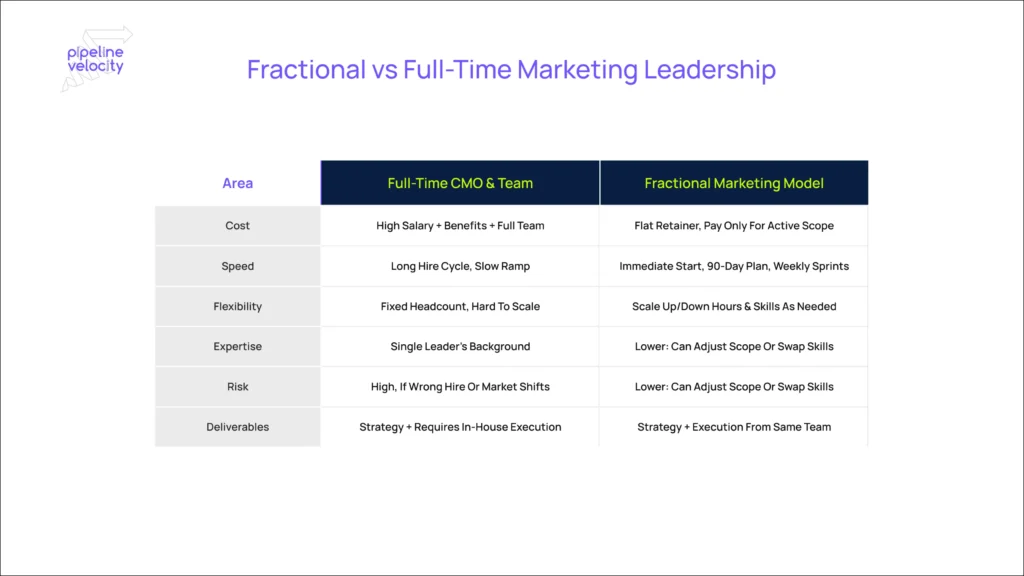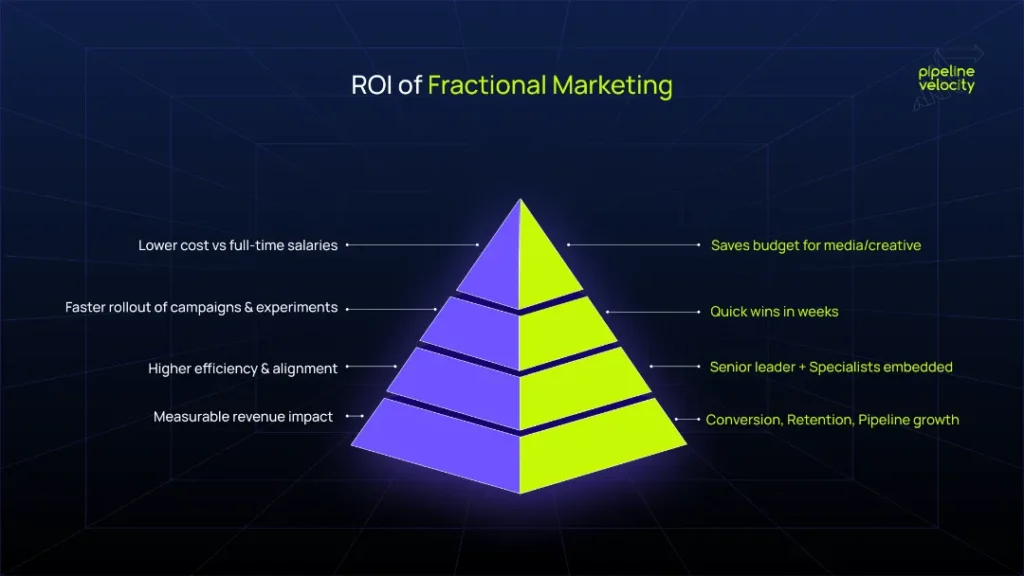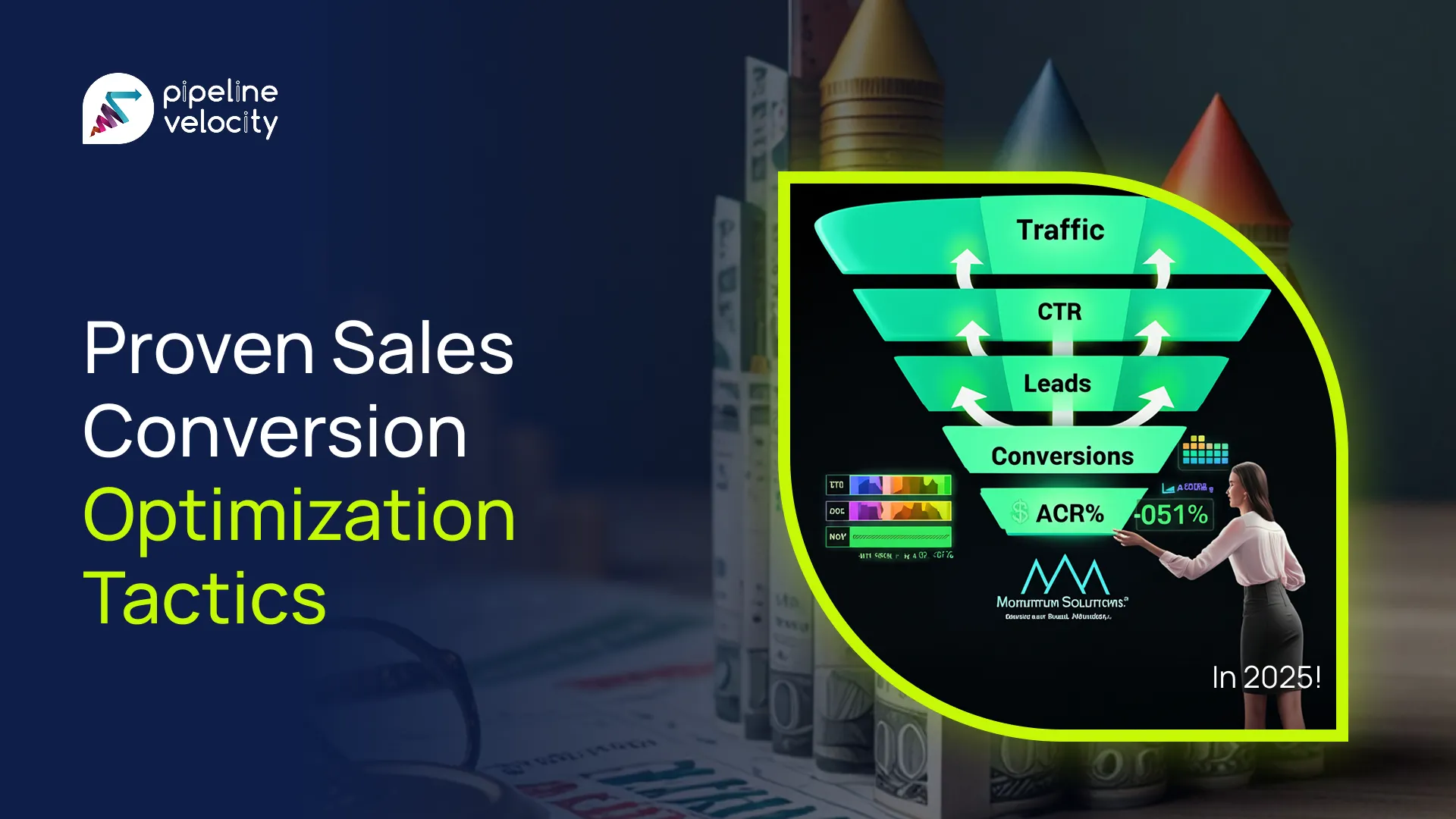What is fractional marketing in plain terms? It gives you a senior marketing leader and a fractional marketing team for a set number of hours each month, so you get high-level strategy and hands-on execution without full-time payroll. A fractional CMO leads go-to-market strategies, aligns your marketing department, and owns outcomes with consistency week after week. Most tech companies see faster go-to-market speed because fractional marketers arrive with proven playbooks, tools, and partners. Cost drops because you pay for the slice of leadership and specialized skills you need, not a full salary with benefits. Brands at the growth stage gain the most since they need experienced marketing leadership, content marketing muscle, data analytics, and performance data to lift conversion rate and marketing engagement.
Our services at Pipeline Velocity for fractional leadership
Our services at Pipeline Velocity bring senior leadership and execution in one package so you can move faster without heavy headcount. We run the plan end to end through CMO as a Service and a dedicated Fractional Marketing Team that plugs into your stack. At Pipeline Velocity, we help you pair strategy with hands-on work using our Growth Marketing Services and channel experts for SEO and PPC. You get tight cadences, clear owners, and reporting that ties to pipeline and revenue. If you want leadership that coaches your team while shipping work each week, this model fits.
What is fractional marketing and how does a fractional CMO fit in
Fractional marketing delivers seasoned leadership and specialized execution on a part-time basis that still moves at enterprise speed. A fractional CMO serves as the marketing leader, sets the marketing strategy, and aligns all marketing efforts to revenue goals and go-to-market strategies. The fractional marketing team covers day-to-day work across search engine optimization, paid media, web design, email, and content marketing while tracking performance data. Companies use this model when they want an experienced marketing expert, not a junior generalist, yet they do not want full-time hires. With a fractional marketing agency or fractional marketing partner, you plug in leadership, templates, and team members who already know how to scale with consistency.
How fractional marketing works vs full-time marketing leadership

A full-time CMO requires a long hiring cycle, a large budget, and a full supporting cast. A fractional CMO joins quickly, builds a 90-day plan, and sets cadence with your marketing teams. You pay a flat monthly fee for leadership and hours from fractional marketers who handle campaigns, analytics, or creative. The plan includes standups, sprint planning, weekly check-ins in Slack, and a roadmap that ties to sales pipeline, conversion rate, and revenue. For a hands-on leader and crew, see our CMO as a Service and Growth Marketing Services. You gain clarity because one marketing officer leads, assigns work, and reports results in language the executive team respects.
Who benefits from hiring a fractional marketer or fractional CMO

Startups that need market validation gain senior guidance without heavy burn. Small business owners who wear three hats get a marketing director who can prioritize and delegate to a fractional team. PE-backed firms, tech companies, and founder-led scale-ups get a chief marketing officer who can build the marketing function, mentor the in-house marketing manager, and install repeatable processes. Established companies that paused hiring still move forward because a fractional marketing team fills gaps across channels. Any brand that needs access to specialized skills such as technical SEO, data analytics, conversion copy, and lifecycle email can benefit from fractional marketing services that scale up or down with demand. For a deeper look at options, read our guide on fractional CMO agency models.
Key characteristics of fractional marketing that drive ROI

Fractional marketing stands out because it focuses on outcomes and speed. You get senior leadership, a flexible bench, and integrated workflows that bring strategy and execution under one roof. This model lowers risk because you can right-size your plan and your spend as your business grows. It also improves accountability because one leader owns the roadmap, the experiments, and the scorecard. The result is a tighter link between marketing work and revenue, stronger marketing engagement, and better conversion rate trends. If you focus on search, see how we approach modern ranking and AI results in our post on SEO vs GEO differences.
Part-time access to senior marketing leadership and specialized skills
A fractional CMO brings enterprise-grade decision making, but you only pay for the scope you need. You also get access to specialized fractional marketers such as media buyers, marketing analysts, and marketing technologists who handle setup and optimization. This blend covers high-level marketing strategy and daily execution, so your marketing department runs as a single unit. You skip the long ramp that full-time employees need because the fractional team arrives with frameworks, scorecards, and tool stacks that include data analytics and performance data dashboards. You gain consistent leadership without the risk of a single point of failure.
Flexibility to scale the fractional marketing team based on growth stage
Your needs change as you move from MVP to product-market fit to scale. A fractional team grows with you, adding hours for paid search, video, or partner marketing when you push new markets. When a quarter calls for brand work, the team shifts toward content, creative, and PR without new headcount. During a product launch, you can add a demand pod that includes a strategist, a lifecycle marketer, and a designer for a defined sprint focused on go-to-market strategies. In a slower season, you dial back to focus on SEO and retention that compound. This flexibility keeps cost aligned with impact every month and preserves consistency across channels.
Integrated support: fractional marketers embed in your marketing department
Fractional marketers do not sit on the sidelines. They join your standups, meet with sales, and write briefs with your product team. The fractional CMO runs quarterly planning and ties experiments to pipeline stages, so the whole marketing function pulls in one direction. The team documents playbooks in your tools and trains your internal staff, which builds lasting capability. You get the benefits of a marketing agency and the control of an in-house team. Day to day, you see Slack updates, quick check-ins, and shared dashboards that keep work moving and keep consistency high.
Cost savings vs hiring a full-time marketing director or CMO
A full-time marketing director or chief marketing officer adds salary, equity, and benefits on top of recruiting costs. You also need analysts, designers, and specialists to support that leader. Fractional marketing replaces those fixed costs with one retainer that covers leadership and execution. You avoid idle time because you fund only active work. The budget you save moves into media, creative, and tools that improve conversion rate and marketing engagement. For an objective checklist of plan elements, the SBA outlines the core parts of a marketing plan you can adapt to this model in its Marketing and sales guide.
Challenges of fractional marketing and how to overcome them
Fractional marketing works when you set clear goals, lines of ownership, and ways of working. Misalignment happens when a company treats the fractional CMO as a consultant, not a leader. Confusion also happens when teams do not know who approves, who briefs, and who reports. You solve this with a written charter, a single scorecard, and a weekly rhythm that puts work in motion. Culture fit matters, so evaluate how the fractional marketing partner communicates and how they coach internal teams with consistency.
Ensuring clear expectations and team alignment with fractional leadership
Start with a one-page plan that lists business goals, marketing goals, and the leading indicators that matter. Define who owns messaging, who owns channel strategy, and who owns analytics. Run weekly standups with agendas that cover wins, blockers, and next steps, and follow with a written recap. Keep a living roadmap where leadership and team members can see current initiatives, owners, and due dates. Hold check-ins in Slack to confirm progress, share performance data, and adjust go-to-market strategies in real time. If you need a structured review, our Marketing Audit Service gives you a prioritized action plan.
Matching the right fractional marketing partner to your company culture
Culture drives speed and trust, so select a partner who fits how your team works. If your company values quick experiments, look for a fractional marketing agency that ships in short sprints and tests often. If your sales cycle runs long, pick a team that knows account-based programs and field enablement. Meet the actual people who will run your account and ask for working sessions, not just a slide deck. Ask how they handle conflict, how they coach internal staff, and how they report results. Tech companies should confirm experience with modern stacks, data analytics, and integrations. For context on channel choices and content, see our post on optimizing blogs for generative engines.
Avoiding pitfalls of overly niche fractional CMOs lacking versatility
Some fractional CMOs focus on one channel or one industry playbook. That can limit options when your market shifts or your product evolves. You want a leader who built demand across search, social, events, and product-led tactics, not just one lane. You also want comfort with both brand and performance so the plan balances near-term pipeline and long-term equity. Test breadth during the evaluation by asking for three alternative go-to-market paths for the same goal and by reviewing how they improved conversion rate after a channel cooled.
Why broad experience in fractional CMOs often leads to better results
Broad experience helps a fractional CMO pick the right strategy for the moment, not the strategy they know best. A leader who grew startups and led large marketing teams can match pace with your growth stage. Leaders who managed in-house teams and agencies can design a model that uses both to your advantage. Breadth also speeds problem solving because they recognize patterns and avoid common traps. That range turns the hard work of market entry into the feat of consistent, compounding wins backed by performance data. For small business owners weighing options, our take on outsourced marketing for small business explains how to blend internal and external help.
Is fractional marketing the best fit for your business?
Fractional marketing fits companies that want seasoned leadership, repeatable process, and measurable outcomes without a heavy headcount. The model suits brands that must prove ROI each quarter and cannot afford months of hiring lead time. It also suits founder-led companies where the CEO wants a marketing officer to translate vision into pipeline. If you have a working product, clear customer profiles, and a sales motion, a fractional team can expand reach and lift conversion rate while raising marketing engagement. If you plan to build an internal department over time, the fractional team can mentor hires and set a strong foundation.
Company sizes and growth stages ideal for fractional marketing services (startups, small businesses, scale-ups)
Pre-seed and seed startups gain guardrails for positioning, launch calendars, and early demand tests. Small businesses gain a marketing director who can set priorities, align vendors, and give the owner time back. Series A to Series C companies gain a chief marketing officer who can run a multi-channel plan and tie it to revenue targets. Founder-led scale-ups and tech companies gain access to specialized skills such as marketing analytics, marketing automation, and creative direction without building those roles in-house yet. Each stage gets the right-sized team and the right level of leadership.
When a full-time CMO or internal marketing team still makes sense
If you run multiple product lines or large field teams, you may need a full-time CMO who can steer many stakeholders day to day. If you have complex channel operations across regions and languages, in-house leaders who sit with cross-functional peers may drive faster decisions. If you already built a strong internal bench and need constant leadership presence in the office, full-time hires can help. When your company sits in a highly regulated space that requires deep domain oversight, a permanent marketing officer may fit best. Weigh scope, speed, and culture to choose the model that serves your plan.
How to choose the best fractional marketing service for your company
The right fractional partner brings a clear process, a track record, and honest communication. You want alignment on outcomes, not just activities. You want leadership that owns results and mentors your team. You also want flexibility so you can add or swap specialists without reworking contracts. Treat selection like any key hire with work samples, references, and a short pilot.
Evaluate track record, marketing goals alignment, and fractional marketing agency fit
Ask for case summaries that show business context, constraints, and measurable outcomes. Share your revenue goals, sales cycle, and deal sizes so the fractional team can model what success looks like. Review their cadence for planning, standups, and reporting to confirm it fits your team. Meet the exact marketers who will work with you and request a working session on a current problem. Check references who can speak to leadership, speed, integrity, conversion rate lift, and how they act on performance data. When you publish case studies or thought leadership, follow the FTC’s guidance on endorsements and disclosures outlined in the Endorsement Guides.
Look for proven fractional marketing services and fractional CMO offerings
A solid partner offers a core set of services with clear deliverables and timelines. Look for strategy sprints, messaging frameworks, channel playbooks, media planning, analytics, and lifecycle programs. Confirm they can supply a marketing manager, a content lead, and a marketing technologist when you need them. Confirm they know the tools your team uses for CRM, automation, and analytics. Ask how they build go-to-market strategies for launches and how they measure marketing engagement during and after each campaign.
Importance of marketing leadership, clear deliverables, and free consultation or onboarding approach

Strong fractional CMOs run a tight kickoff that sets direction and builds trust. Look for a free consultation or discovery call that explores your goals and constraints. Expect a concise scope with milestones, owners, and definitions of done for each deliverable. Ask for a 30-60-90 plan that covers quick wins, pilot programs, and longer plays. Clarity at the start prevents drift later and makes performance reviews simple, especially when you share dashboards that blend data analytics and qualitative insights. If you want a quick read on your current state, start with a Marketing Audit Service.
ROI of fractional marketing you can expect
ROI comes from speed, focus, and the right mix of skills. A fractional CMO cuts decision time, sets a test plan, and aligns budget with channels that show lift. The team flies in formation so content, media, and web changes support the same outcomes. You measure more than clicks and views because the plan maps to pipeline, win rates, conversion rate, and customer value. Over time, this discipline compounds into lower acquisition cost, higher marketing engagement, and stronger retention. For context on how content still drives demand, see our post on blogs in 2025.
Lower overall cost of marketing leadership compared to full-time hires
A single salary for a senior leader can exceed an entire fractional program that also includes specialists. You avoid recruiting fees, long notice periods, and onboarding time. You also avoid paying for idle capacity when project load dips. The money you save funds media tests and creative that move the needle. You see the shift in performance data that proves the model works.
Faster rollout of strategy and tactics by experienced fractional teams
Experienced fractional marketers carry playbooks for quick discovery, message testing, and channel setup. They can build a positioning doc, an editorial calendar, and a paid search structure in weeks, not quarters. They ship early versions, track data, and tune weekly. They also uplevel internal staff with templates and coaching so work accelerates even when the fractional team steps back. Their go-to-market strategies land faster and deliver repeatable wins.
Increased marketing efficiency, team support, and measurable performance impact
Efficiency grows when one leader sets priorities and kills low-value work. The team builds standard operating procedures for briefs, reviews, and reporting. Shared dashboards keep attention on leading indicators that matter, such as qualified pipeline and demo-to-win rates. Sales and marketing alignment improves because the fractional CMO runs joint reviews on funnel health and messaging. These habits drive consistency across campaigns and cut waste.
The future of fractional marketing and fractional CMO leadership
Fractional leadership keeps rising because companies want expert help with less risk and more agility. Marketing changes fast, and no single full-time hire covers every skill your plan may need in a year. A fractional model gives you a leader who can pull in the right specialists at the right time. It also gives your internal team a coach who builds process that lasts. Expect more companies to adopt fractional marketing teams across growth stages, especially among tech companies that prize speed and data.
Why fractional leadership models are gaining popularity across industries
Finance brought in fractional CFOs years ago, and now marketing follows the same arc. Boards and founders like the model because it matches spend to outcomes and keeps options open. The labor market favors flexible teams that can scale up or down without layoffs. Tech stacks change every quarter, and fractional teams learn the new tools on their own time. The result is stronger resilience and better unit economics proven by performance data and data analytics. When content includes testimonials or influencer work, align disclosures with the FTC’s Endorsement Guides.
How fractional marketing supports capital-efficient, flexible growth strategies
Capital efficiency matters in every market cycle. Fractional marketing lets you run lean while you prove channels and messages. When you find traction, you scale the same team that built the plan, so momentum stays high. If market conditions shift, the team pivots without the drag of restructuring. That flexibility keeps you moving toward revenue targets while you improve conversion rate and nurture marketing engagement.
The evolving trend of fractional leadership models for marketing and beyond
Fractional leadership now extends to product, revenue operations, and data. Companies use fractional chiefs to build foundations, train staff, and set the right metrics. Marketing sits at the center because demand drives the plan for the rest of the business. Expect tighter integration between fractional CMOs, CROs, and product leaders as companies seek shared scorecards. Their shared go-to-market strategies align teams around one plan and one set of numbers.
At Pipeline Velocity, we help you scale with fractional CMO support
At Pipeline Velocity, we help you turn strategy into lift with leadership and channel execution under one roof. Our CMO as a Service provides the senior ownership your plan needs, and our Fractional Marketing Team ships work every week. We pair this with Growth Marketing Services and diagnostic support from our Marketing Audit Service to keep the roadmap tight. You keep control of your tools and data while we run standups, scorecards, and experiments that map to pipeline and revenue. If you want an accountable partner who acts like an extension of your team, this mix works.
In summary…
A short recap helps you act with confidence and choose the right model for your brand. The points below condense the full guide into practical takeaways you can apply this quarter.
- Fractional marketing delivers leadership and execution that match your growth stage.
- A fractional CMO sets strategy and owns outcomes.
- Specialists handle SEO, paid, content, and analytics with consistency.
- A fractional CMO sets strategy and owns outcomes.
- The model cuts cost and raises speed compared with full-time hires.
- You fund only the work you need when you need it.
- Savings move into media and creative that drive results.
- You fund only the work you need when you need it.
- Success depends on clear goals, owners, and cadence.
- Write a one-page plan and keep a live roadmap. Use the SBA’s planning guidance as a baseline.
- Hold weekly check-ins in Slack and share a single scorecard.
- Write a one-page plan and keep a live roadmap. Use the SBA’s planning guidance as a baseline.
- Measure what matters and improve quarter by quarter.
- Track conversion rate, pipeline, and marketing engagement.
- Use performance data and data analytics to steer tests.
- Track conversion rate, pipeline, and marketing engagement.
- Choose partners with breadth, proof, and range.
- Look for case outcomes, tool depth, and culture fit.
- Favor leaders who coach your team and communicate simply.
- Look for case outcomes, tool depth, and culture fit.
This model turns marketing into a system that compounds. If you want a clear plan, faster execution, and accountable leadership, fractional marketing gives you a strong path forward and the feat of sustainable growth.
FAQs
What exactly is fractional marketing vs fractional CMO?
Fractional marketing refers to a service model where you engage senior leadership and a marketing team on a part-time basis. The fractional CMO plays the role of chief marketing officer, sets the marketing strategy, and leads the program across channels. The broader fractional team includes specialists such as content strategists, media buyers, and marketing technologists who execute the plan. The two work together so you get leadership and hands-on work in the same engagement. Teams track conversion rate, marketing engagement, and pipeline so you see outcomes in the numbers.
Can fractional marketers integrate with my existing marketing team?
Yes, and the best teams embed fully. They join your standups, work in your tools, and run reviews with sales and product so everyone pulls in the same direction. They document playbooks, train internal staff, and leave assets that your team can reuse. The fractional CMO coordinates priorities and sets guidelines so in-house and external resources work as one. Expect Slack communication, weekly check-ins, and shared dashboards that tie to performance data.
What cost savings can I expect compared to hiring full-time?
Most companies save the equivalent of one or more senior salaries when they choose a fractional model. You avoid recruiting fees, onboarding cost, and benefits. You also avoid paying for idle time because you fund only active scope. Those savings can move into high-impact areas such as creative development, media tests, and conversion optimization. The total return often shows up as lower acquisition cost, stronger marketing engagement, and better conversion rate.
How soon can fractional marketing deliver results?
A capable fractional team sets a plan within the first weeks and starts shipping early wins in the first month. For example, you can see quick gains from technical SEO fixes, landing page updates, and message testing in paid search. Larger plays such as lifecycle email and content engines show traction within a quarter. The fractional CMO sets targets by month and quarter, then measures progress against the scorecard. You see the gains in performance data that the team shares in weekly check-ins.
How do I know if my business is ready for fractional marketing leadership?
You stand ready if you know your customer, have a working product, and want a tighter link between marketing and revenue. You also stand ready if your team feels stretched across too many tasks and you lack senior leadership. If hiring full-time leaders feels premature or too costly, a fractional model brings structure and results without the long commitment. If you plan to build an internal department over time, fractional leaders can mentor your hires and install process. A short discovery call can confirm fit and map the first 90 days with clear go-to-market strategies.




